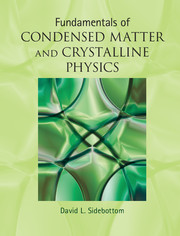 Fundamentals of Condensed Matter and Crystalline Physics
Fundamentals of Condensed Matter and Crystalline Physics from Part IV - Transitions
Published online by Cambridge University Press: 05 August 2012
Introduction
We have now witnessed the similar patterns associated with second-order phase transitions in both fluid and magnetic systems. These patterns include laws of corresponding states and similarity in critical exponents, that govern how properties evolve near the transition point. Furthermore, the Landau theory provides a framework for understanding the commonality of these second-order phase transitions, in terms of similarity in the functional dependence of the free energy on an appropriately chosen order parameter, and a simple expansion that can be performed near the critical point. In this chapter, we examine yet another significant phase transition found in condensed matter: the transition of a material to a state of virtually infinite conductivity or superconductivity. Here the transition involves the sticking together of two electrons into a boson-like, superconducting charge carrier known as a Cooper pair, and we again find evidence of a second-order transition consistent with mean field theory.
Superconducting phenomena
Discovery
In 1908, H. K. Onnes perfected the technique for cooling helium gas to its condensation point and soon after began using this new technology to investigate the properties of various elements at ultra low temperatures. In one instance, Onnes was curious about the ultimate demise of the resistivity of an electronic conductor. As we saw in Chapter 12, the resistivity of most conductors decreases linearly with temperature at high temperatures, due to the scattering of electrons by lattice phonons, but approaches a limiting value at low temperatures, associated with a mean free path determined by macroscopic imperfections of the crystal lattice. In a series of studies, Onnes measured the resistance of gold and platinum and observed an approach to a limiting resistance at low temperatures. In an effort to eliminate the effects of imperfections, he extended the study in 1911 to include mercury, which at that time could be refined to a highly pure form. The results of this study, shown in Fig. 18.1, are quite dramatic. A roughly linear temperature dependence was observed above about 4.2 K, which decreased abruptly to an immeasurably small resistance at lower temperatures. On reheating, the resistance was identically retraced, and Onnes concluded that mercury had undergone a unique phase transition to a new state characterized by virtually zero resistance – a “superconducting” phase.
To save this book to your Kindle, first ensure [email protected] is added to your Approved Personal Document E-mail List under your Personal Document Settings on the Manage Your Content and Devices page of your Amazon account. Then enter the ‘name’ part of your Kindle email address below. Find out more about saving to your Kindle.
Note you can select to save to either the @free.kindle.com or @kindle.com variations. ‘@free.kindle.com’ emails are free but can only be saved to your device when it is connected to wi-fi. ‘@kindle.com’ emails can be delivered even when you are not connected to wi-fi, but note that service fees apply.
Find out more about the Kindle Personal Document Service.
To save content items to your account, please confirm that you agree to abide by our usage policies. If this is the first time you use this feature, you will be asked to authorise Cambridge Core to connect with your account. Find out more about saving content to Dropbox.
To save content items to your account, please confirm that you agree to abide by our usage policies. If this is the first time you use this feature, you will be asked to authorise Cambridge Core to connect with your account. Find out more about saving content to Google Drive.